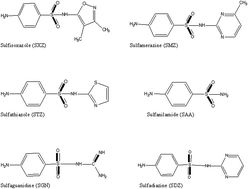Validation of a screening method for the rapid control of sulfonamide residues based on electrochemical detection using multiwalled carbon nanotubes-glassy carbon electrodes
Abstract
An amperometric screening method for the control of sulfonamides in different matrices has been developed. The detection was improved by using multiwalled carbon nanotubes-glassy carbon electrodes (MWCNTs-GCE). Six representative sulfonamides (SAAs), namely, sulfanilamide, sulfaguanidine, sulfamerazine, sulfisoxazole, sulfathiazole and sulfadiazine were selected for this purpose. Statistical analysis of the obtained data demonstrated that this type of modified electrodes presented considerably better stability and sensitivity than the conventional unmodified ones. Detection limits were in the 0.01 and 0.04 μg mL−1 range, whereas quantification limits were between 0.05 and 0.1 μg mL−1. The usefulness of the method was demonstrated by the analysis of different types of samples. Particularly interesting is the application to milk samples, where the European legislation establishes a maximum residue level for SAAs at 0.1 μg mL−1. The developed method was demonstrated to be a good alternative screening method for this threshold of reference, with an unreliability zone of between 0.05 and 0.09 μg mL−1, which is useful for the reliable classification of milk samples.


 Please wait while we load your content...
Please wait while we load your content...